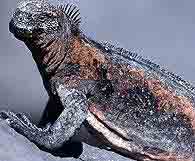VOICE ONE:
I'm Shirley Griffith.
VOICE TWO:
And I'm Steve Ember with EXPLORATIONS in VOA Special English. Today, we tell about the Galapagos Islands in the Pacific Ocean and the unusual creatures that live there.
(MUSIC)
VOICE ONE:

The 19 islands that make up the Galapagos lie along the equator 1,000 kilometers west of Ecuador. The islands are named for the giant tortoises that live there. Galapagos has been called "a living museum and showcase of evolution." The animals on the islands influenced British nature scientist Charles Darwin's ideas about evolution by natural selection.
In 1978, the islands were the first place named to the World Heritage List by the United Nations Educational, Scientific and Cultural Organization. In 2007 UNESCO added the islands to its World Heritage in Danger list. The main reason is the increase in the number of visitors to the islands.
The World Heritage Committee said increased tourism, immigration and invasive species threaten the animals of the Galapagos. Many of these animals are found nowhere else in the world. The committee noted that the number of days spent by passengers on ships in the area has increased by 150 percent in the last 15 years. More than 170,000 people visited the islands last year.
VOICE TWO:
Increased tourism has brought thousands of workers from Ecuador to the Galapagos Islands to seek jobs. Some workers have brought non-native animals like dogs, cats, pigs and goats. These animals compete for food with the islands' native animals. Some also attack the native animals. And the waste produced by the islands' growing human population places an increased threat on the wildlife.
The Ecuadorian government has tried to enforce severe limits on the number of Ecuadorians who move to the islands. But many Ecuadorians have criticized the government's efforts. They feel they have the right to live on the islands to make a better living.
VOICE ONE:
A new report in the journal Global Change Biology says the ecosystem of the Galapagos Islands has changed forever. This destruction is due to human activity in addition to warming water temperatures and overfishing.
Researchers who wrote the report say at least 45 species are now extremely threatened. And they say that it is likely that two species are probably gone forever. These are the Galapagos damsel fish, and the 24 rayed sunstar.
(MUSIC)
VOICE TWO:
Mystery has always been part of the Galapagos Islands. In 1535, a ship carrying the Roman Catholic Bishop of Panama came upon the Galapagos accidentally. Tomas de Berlanga named the Galapagos group the Enchanted Isles. He was surprised to see land turtles that weighed more than 200 kilograms and were more than one meter long.
He said they were so large each could carry a man on its back. Bishop Berlanga also noted the unusual soil of the islands. He suggested that one island was so rocky it seemed like stones had rained from the sky.
VOICE ONE:

Ecuador took official possession of the islands in 1832. The British nature scientist Charles Darwin is mainly responsible for the fame of the Galapagos Islands. He visited the islands in 1835. He collected plants and animals from several islands. After many years of research, he wrote the book "The Origin of Species" in 1859. He developed the theory of evolution that life on Earth developed through the process of natural selection.
The book changed the way people think about how living things developed and became different over time. Darwin said the Galapagos brought people near "to that great fact -- that mystery of mysteries -- the first appearance of new beings on earth."
One hundred years later, in 1959, the Ecuadorian government declared almost all of the islands a national park. The Charles Darwin Foundation was formed the same year to study and protect the plants and animals on the islands.
(MUSIC)
VOICE TWO:
More than 125 landmasses make up the Galapagos. But only 19 are large enough to be considered islands. Scientists have been wondering for years about the position of the Galapagos in the Pacific Ocean. Scientists used to think that the islands were connected to the South American mainland and floated out to sea slowly.
Today, most scientists think the islands were always where they are now. But they think the islands once were a single landmass under water. Volcanic activity broke the large island into pieces that came to the surface of the sea over time.
VOICE ONE:
But scientists wonder how animals arrived on Galapagos if the islands were always so far from the mainland. Scientists think most Galapagos plants and animals floated to the islands. When rivers flood in South America, small pieces of land flow into the ocean. These rafts can hold trees and bushes. The rafts also can hold small mammals and reptiles. The adult Galapagos tortoise clearly is too big for a trip hundreds of kilometers across the ocean. But, turtle eggs or baby turtles would be small enough to float to the islands.
VOICE TWO:

The Galapagos Islands are home to many unusual birds, reptiles and small mammals. Some of the animals live nowhere else on Earth. The tortoise is the most famous Galapagos reptile. But the marineiguana is also unusual. It is the only iguana in the world that goes into the ocean. It can dive at least 15 meters below the ocean surface. And it can stay down there for more than 30 minutes.
In 2009 scientists confirmed the discovery of a new species of iguana. This pink iguana is believed to be a more ancient form of the species than other known iguanas on the islands. This newly discovered iguana has a pink head with black stripes on its body.
Several strange birds also live on the Galapagos. One of them is the only penguin that lives on the equator. Another is the frigate bird. It has loose skin on its throat that it can blow up into a huge red balloon-like structure. It does this to attract females that make observation flights over large groups of males.
VOICE ONE:
The Galapagos also are noted for a bird that likes water better than land or air. The cormorant is able to fly in all the other places it lives around the world. But the Galapagos cormorant has extremely short wings. They cannot support flight. But they work well for swimming.
The islands also have a large collection of small birds called Darwin's finches. Charles Darwin studied the finches carefully when he visited the Galapagos in 1835. He separated the birds by the shapes of their beaks. He discovered that finches that lived in different places and ate different foods had different shaped beaks.
(MUSIC)
VOICE TWO:

But the most famous animals on the Galapagos Islands are the thousands of giant tortoises. And the most famous of these is the one that scientists call Lonesome George because he is the last of his kind.
He has been called the rarest creature on Earth. At one time, the islands were home to about 15 different kinds of land turtles. The largest island, Isabela, has five different kinds of tortoises. But, Lonesome George is not one of them. He comes from a smaller island called Pinta.
Scientists found George in 1971. Humans and non-native animals had caused much damage to the environment on his island. Some animals and plants had disappeared. Lonesome George was the only tortoise found on Pinta.
VOICE ONE:
Scientists took the tortoise to the Charles Darwin Research Center on Santa Cruz Island. They wanted to help him find a female tortoise for mating to produce baby tortoises. The scientists had been successful in similar efforts for thousands of other tortoises.
The researchers placed George in the same living area as females from the nearby island of Isabela. Scientists thought George would be more closely related to the females from Isabela than to other Galapagos tortoises. In 2008, George surprised scientists by mating for the first time in 36 years.
Scientists took the eggs to a laboratory where they could be protected and closely observed. Unfortunately, the eggs were later found to be infertile. But new eggs have appeared in two nests over the past year. Although he is between 90 and 100 years old, George may yet become a father. So, there is still hope that in the near future, George will not be quite as "lonesome" anymore.
(MUSIC)
VOICE TWO:
This program was produced by Dana Demange. I'm Steve Ember.
VOICE ONE:
And I'm Shirley Griffith. Transcripts and archives of our shows are at voaspecialenglish.com. Join us again next week for EXPLORATIONS in VOA Special English.
damsel fish: a kind of marine fishes of tropical waters
iguana: any of various large tropical American lizards of the family Iguanidae, often having spiny projections along the back 鬣蜥蜴
frigate bird: any of various tropical sea birds of the family Fregatidae that have long powerful wings, dark plumage, and a hooked beak and characteristically snatch food from other birds in flight 军舰鸟
cormorant: any of several large, widely distributed marine diving birds of the genus Phalacrocorax, having dark plumage, webbed feet, a slender hooked bill, and a distensible pouch 鸬鹚
finch: any of various relatively small birds of the family Fringillidae, including the goldfinches, sparrows, cardinals, grosbeaks, and canaries, having a short stout bill adapted for cracking seeds 雀科鸣鸟
Related stories:
Cliffhanger: rock climbing as sport and art
The Great Lakes and famous shipwrecks
Getting a feel for textile arts around the world
Exploring the art of jewelry across the ages
(来源:VOA 编辑:陈丹妮)